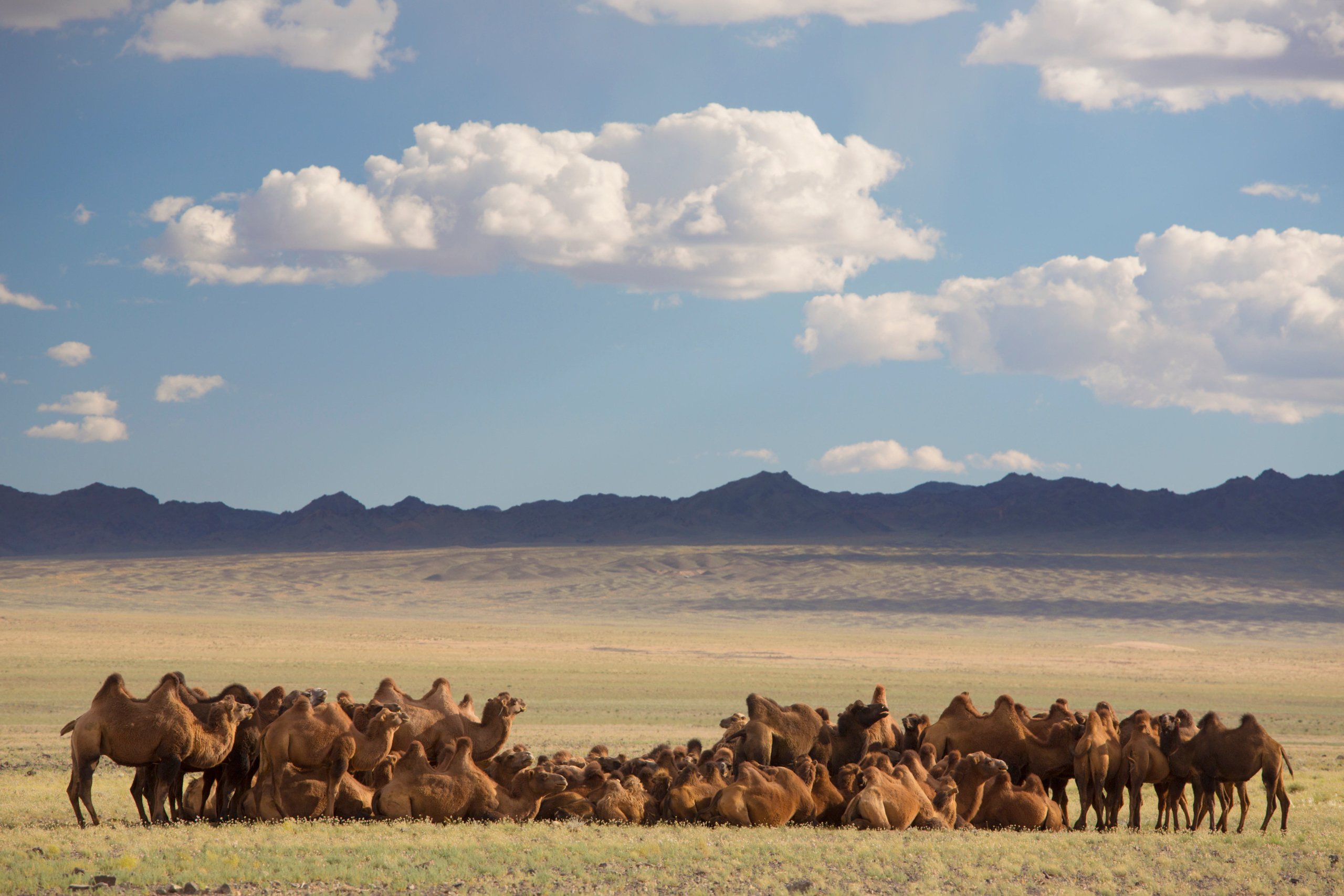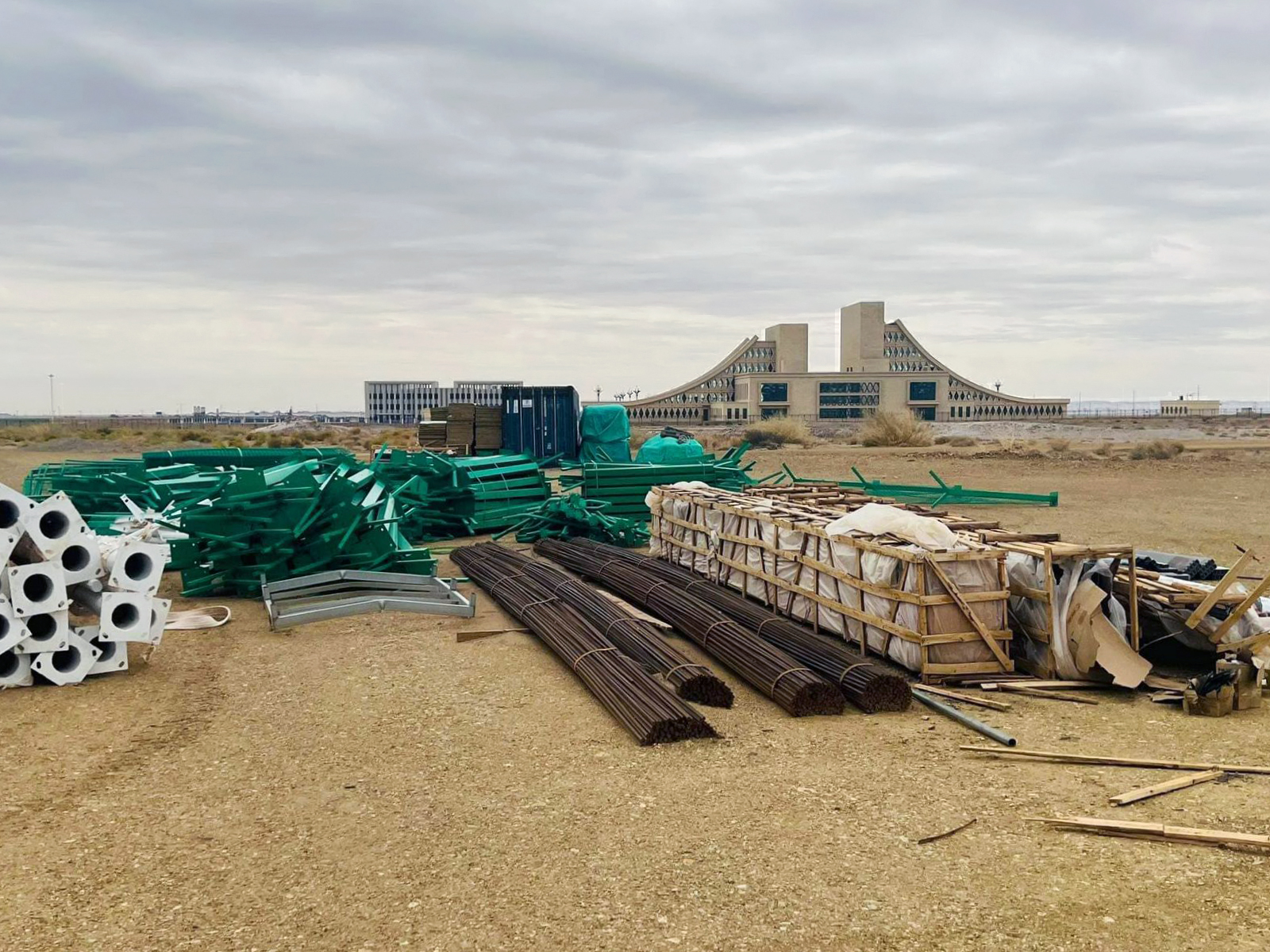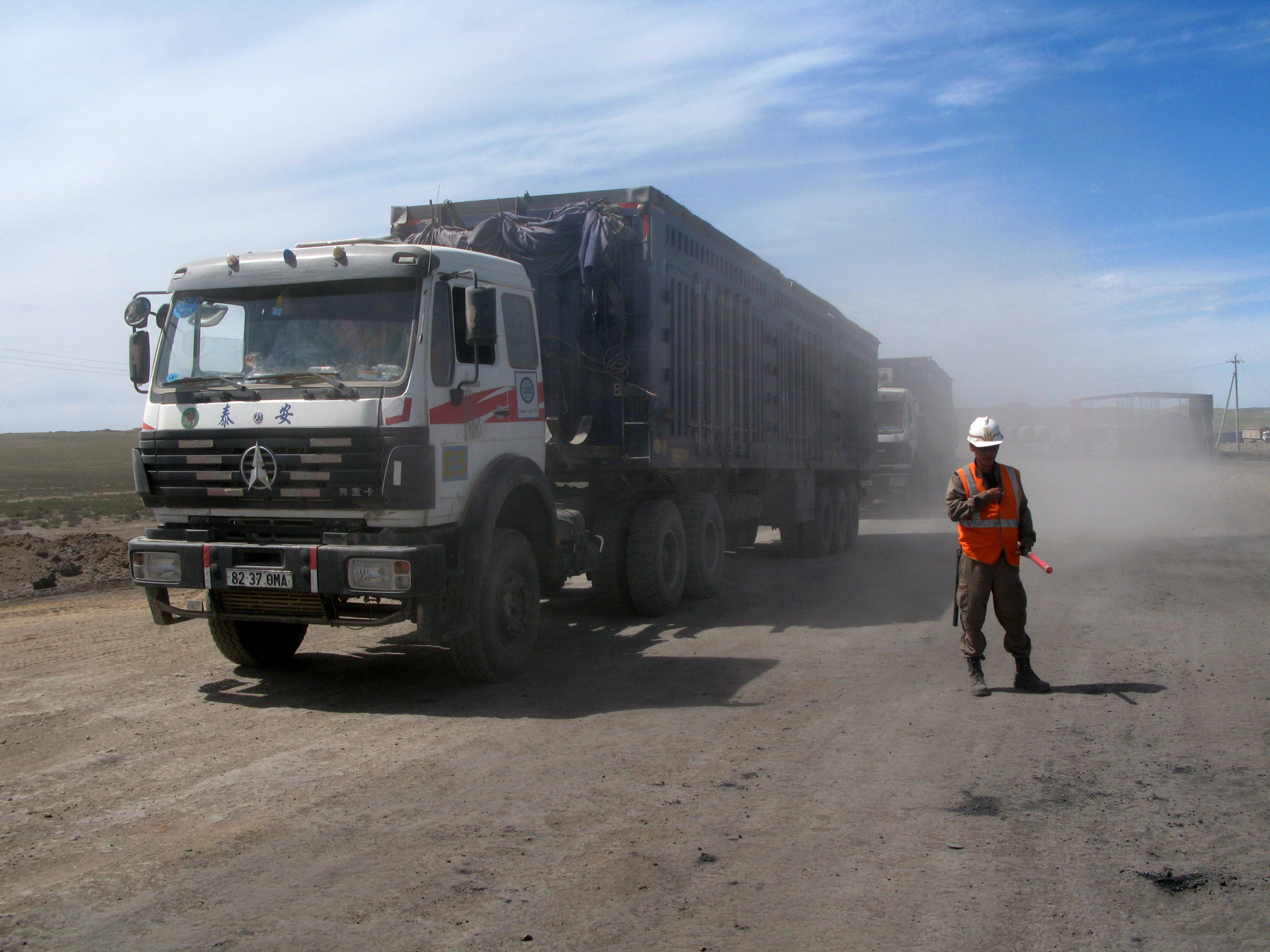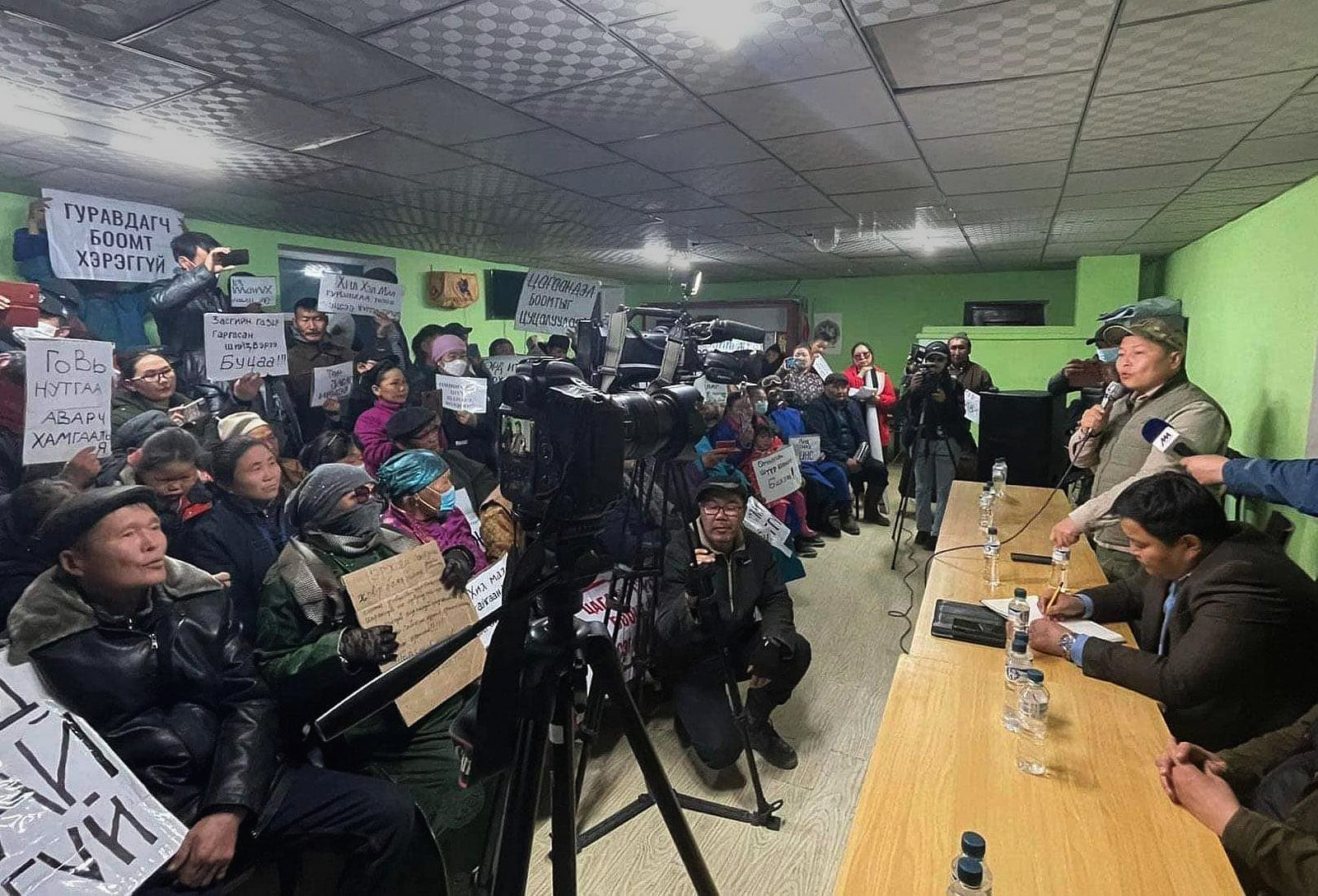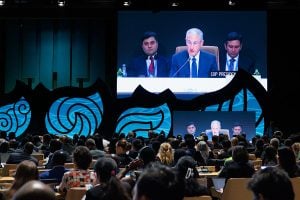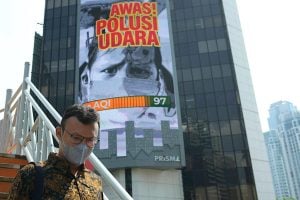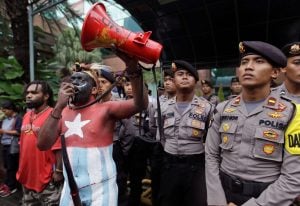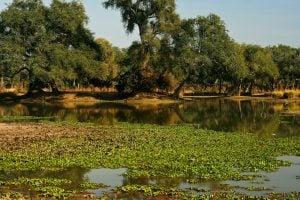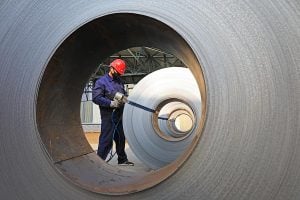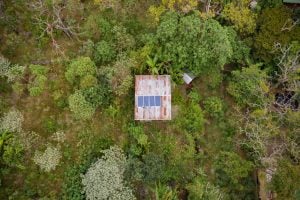Nearly 85% of Mongolia’s exports go to its southern neighbour, China, and must pass through one of eight checkpoints along the two countries’ 4,709-kilometre-long border. More than half of it is coal, which forms the backbone of Mongolia’s trade with China. In Ömnögovi, a new border checkpoint and a road are being built to connect China to existing and proposed coal mines dotted across this southern Mongolian province.
The Tsagaan Del Uul-Ölzii checkpoint was completed on the Chinese side in 2021, and that section now towers over the vast gravel plains of the Gobi Desert. The checkpoint is close to the Small Gobi Strictly Protected Area, an ecologically important site home to wildlife such as the ibex, argali and long-eared jerboa. In 2021, China lent RMB 418 million (USD 58.2 million) to Mongolia for construction of the checkpoint on its side of the border.
Since 2018, local herders have been protesting the construction of the road and checkpoint, often riding their motorcycles in the middle of the night to obstruct trucks carrying building materials. In 2022, Prime Minister Oyun-Erdene Luvsannamsrain met with herders in the provincial capital, Dalanzadgad. In response to their requests, he announced the project would be suspended.
Construction was halted until May 2024, when the border crossing was temporarily opened to allow construction materials to be brought in from China. During our research trip to examine rural livelihoods in August and September 2024, herders told us they fear this new infrastructure and the accompanying proliferation of coal mining sites will irreparably damage this unspoilt part of the Gobi. They say it could kill their livestock and ultimately bring about the end of their pastoral way of life.
Checkpoints and chokepoints
In 2017, delays at one of the Mongolia-China border checkpoints resulted in a traffic jam stretching up to 130 kilometres, made up of coal trucks inching their way towards China. One of the pillars of Mongolia’s post-Covid New Recovery Policy is to increase the capacity of border checkpoints, and the infrastructure that leads to them; in 2022, Mongolia opened a new railway line to the Chinese border.
Following an unofficial ban on coal imports from Australia in 2020, China has increasingly turned to Mongolia, particularly for coking coal used in steelmaking. Even after the ban on Australian coal was lifted in 2023, demand for Mongolian coal remains strong, partly thanks to competitive prices stemming from improvements in border infrastructure. In 2021, Mongolia exported 14 million tonnes of coking coal to China; by 2023, this had increased to 54 million tonnes.
Given China’s ambitions to decarbonise, however, Mongolian government officials have openly acknowledged they have a limited “window of opportunity” to export as much coal as possible. They argue this revenue will be used to diversify the country’s economy.
While the boom in coal exports may be leading to more economic activity in Ömnögovi, where many of the mines are concentrated, its flipside has been environmental damage. Mining uses significant amounts of groundwater, depleting scarce resources that herders, livestock and wild animals rely upon for survival.
The transportation of mined materials including coal to the Chinese border has also caused problems for herders, as trucks travel on unpaved roads, killing livestock and churning up dust, with implications for human and animal health.
When we visited Erdenebulag, one of the mining sites along the planned road to the Tsagaan Del Uul-Ölzii checkpoint, large mounds of “overburden” (organic material lying above deposits of exploitable resources) suggested operations had already progressed significantly before the protests halted them. We saw that the site had been cordoned off with tall fences; locals told us that wild animals, such as gazelle, had died after becoming ensnared in them.
Mining is becoming increasingly contentious at the national level, too. In December 2022, protests broke out in the Mongolian capital, Ulaanbaatar, after revelations that state owned company Erdenes-Tavan Tolgoi JSC had been selling coal illegally to China, by forgoing customs registration. Sourced from one of the world’s largest coking coal mines, the Tavan Tolgoi mine in Ömnögovi, these actions amounted to an estimated MNT 40 trillion (USD 13 billion) in lost revenue. State officials were implicated, and the scandal was widely regarded as an egregious example of the systemic corruption that has plagued Mongolia.
Opposing the new coal highway
Tsagaan Del Uul-Ölzii would be the third checkpoint in Ömnögovi province, and a new road is being planned that will connect it to the Tavan Tolgoi mine. The road would enable companies with licenses for mines in the area – which contains numerous, significant deposits of coking coal – to open new ones along its length. Over 70 companies, many of them Chinese, have such licenses.
One of the areas the road would traverse is Khurmen, a soum (district) on the Mongolia-China border. Visiting Khurmen, herders told us they were worried trucks travelling from the mines and onto this road would damage their pastures. They would also threaten their camels herds, which are accustomed to wandering freely.
Buyannemekh, a herder who lives a few kilometres from the planned road, says: “If a third checkpoint is built, our rare camels will have no way to survive, herders will have no way to survive, and our Gobi homeland will end up completely deserted.” Herders say they had seen the areas surrounding mines elsewhere in the province. “There’s no development there, only chaos,” one told us.
Bayarsaikhan Namsrai is director of the Mongolian NGO Steps Without Borders, which works with herders in the region. “Opening this border crossing might seem important for Mongolia’s current economic growth, but this is far outweighed by the long-term damage that will be caused,” she says.
The Tsagaan Del Uul-Ölzii checkpoint was first proposed by authorities in Alasha Left Banner in 2004. In 2006, it was included in a plan drawn up by China’s state council to construct 12 new border crossings between 2011 and 2015. In 2014, Xi Jinping and the then-Mongolian President, Tsakhiagiin Elbegdorj, signed a joint strategic partnership declaration that included an agreement to open the border crossing.
While Chinese reports make it clear that a core purpose of the crossing from its inception was to enable Chinese mining companies to expand into Mongolia, herders in Khurmen say they were initially told it would be a tourism crossing. Locals like Baatar, a herder, note that they were not opposed to this: “It would be good if they could develop the desert dunes in Khurmen for tourism.”
In 2018, however, herders learned the crossing would be used solely for the transportation of coal. Mongolian officials told us it will eventually become multipurpose, and that herders themselves will thus be able to benefit from cross-border trade. Herders in Khurmen and neighbouring Nomgon soum began to express their opposition to the checkpoint and road in local meetings. They claim the consultation process was not correctly followed, and their formal opposition to the project was not properly communicated to higher levels of government. Herders say this prompted them to take direct action from 2018, blocking trucks carrying construction materials.
Shortly after the government announced the checkpoint project’s suspension in May 2022, the Chinese government sent a letter to its Mongolian counterparts expressing its desire for the project to continue.
Herders say that during the spring, one local herding couple was arrested for blocking trucks on the Mongolian side. On 11 October, local elections were held in Mongolia. Post-election, herders tell us they fear there is little incentive for politicians to further delay construction.
In the words of Buyannemekh, “we’re now living on a Chinese coal field.” But though many are pessimistic about the future, they continue opposing the work. The herders say they are preparing to write letters to politicians and deliver them directly to Ulaanbaatar themselves.
